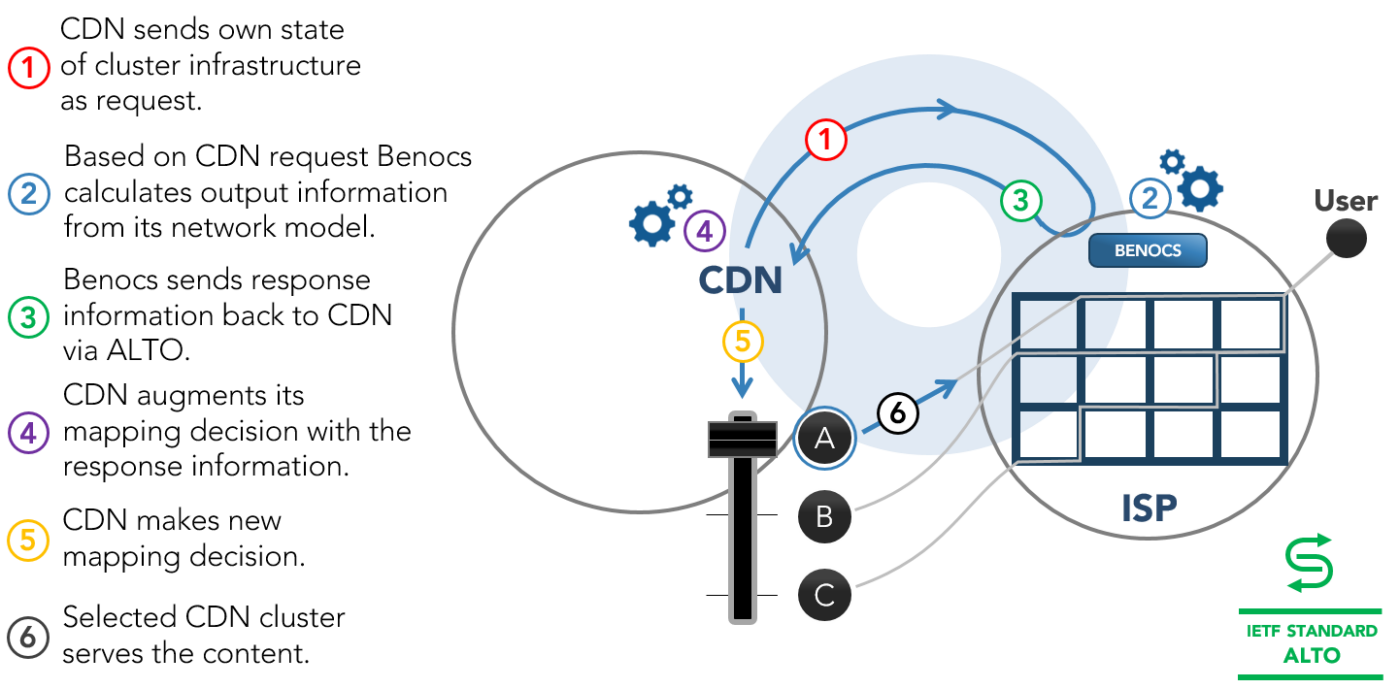Back in 2010, before BENOCS, our founder along with a few other researchers presented the new challenges facing ISPs: CDNs/hyper-giants and their poorly mapped traffic. In that proposal[1], they opened the research community to a new idea: the prospect of creating a system that would be implemented in the ISP network, which would use the network’s data to facilitate better mapping from the CDN/hypergiants’ side. Now, nine years later and six years of development, the system called BENOCS Flow Director is not only running, but has also proven its viability and is showing positive results.
This year, BENOCS, along with researchers from Max Planck Institute for Infomatics, TU Berlin and TU Munich, is proud to report on its progress since its system, the BENOCS Director, enabled the first ISP/CDN cooperation in 2017, which will be presented at both ACM CoNEXT 2019 and APNIC 49.
Hyper-giants and their behavior on the network
So what are we talking about when we talk about hyper-giants and ISP/CDN cooperation? For us, a hyper-giant is a large network that sends at least 1% of total traffic delivered to broadband customers in the ISP network and publically identifies as a CDN, cloud, content or enterprise network. Since the introduction of video and social networks, demand for content has risen rapidly, causing CDNs to become more relevant for ISP networks: the top ten – mostly hyper-giants – being responsible for more than 50% of the traffic on the network . With traffic sizes that significant, it is important that CDNs of all kinds deliver their traffic as accurately as possible in order to reduce congestion on ISP networks and provide the best quality of service.
Given the rapid growth, ISPs and CDNs have also been challenged with trying to keep up with one another’s development, causing them to make unavoidable upgrades just to maintain the quality of service. This lack of visibility has resulted in an extraordinary amount of stress on ISP networks as well as higher costs and maintenance for both sides. Before the BENOCS Director, as well as in some cases today, ISPs and CDNs have implemented their own methods when trying to cope with the growth of content demands and traffic on the network, such as performing their own measurements, which can only provide “best guesses” of the current network state. This is becoming more challenging as CDNs and hypergiants expand and connect more ingress points to the ISP network – which create more path options for them to take.
BENOCS Flow Director improves network traffic
Since both ISPs and CDNs need to co-exist on the network and require visibility of the other in order maintain their performance, why not get them working together? That is how BENOCS Flow Director was born.
BENOCS Flow Director is “an ISP service enabling ISP-CDN collaboration with the goal of improving the latter’s mapping,” according to the research paper, thus reducing costs and improving services for both parties. It does so by collecting and processing the necessary data at scale from the ISP to be able to compute mapping recommendations. It then uses this information to rank every possible ingress point from best to worst and gives this information to the CDN. It is a unique system that was intentionally designed to be vendor diagnostic, deployment agnostic, easy to integrate, fully automated and scalable, so that it could fit into any network and work with any CDN/hypergiant.
According to the research paper, two years after connecting the first hypergiant to a large ISP, it is already working. When the cooperation started, the hypergiant was delivering 70% of its traffic optimally with the trend declining. The combined interest of optimizing network traffic ultimately motivated the CDN to test BENOCS Flow Director. As of today, this metric is in the range of 75-84% and increasing.
Benefits of the Director for ISPs and CDNs
So, what would happen if all major hypergiants were to active BENOCS Flow Director? According to the research paper:
- Theoretically, an ISP could see a 20% long haul decrease is traffic reduction, given the CDNs do not have constraints.
- Every CDN is different, with some able to reduce their long haul traffic in an ISP network by 40% – this happens because some CDNs interconnect with the ISP at different PoPs, and their traffic matrices differently.
- If the system were to be used by all CDNs, the traffic on long-haul links would further reduce to less than 80%
All of which would eliminate guesswork to create a better and more stable network ecosystem, leading to higher quality of service along with a reduction of network infrastructure in use.
This post is based on the research paper Steering Hyper-Giants’ traffic at Scale. We are proud to announce that it won “Best Paper Award” at ACM CoNEXT, 2019 in Orlando, FL and the IRTF’s “Applied Networking Research Prize” for our CTO, Ingmar Poese, in 2020. You can read the full paper here.
[1] Poese, I., Frank, B., Ager, B., Smaragdakis, G., Uhlig, S., & Feldmann, A. (2011). Improving content delivery with PaDIS. IEEE Internet Computing, 16(3), 46-52.
